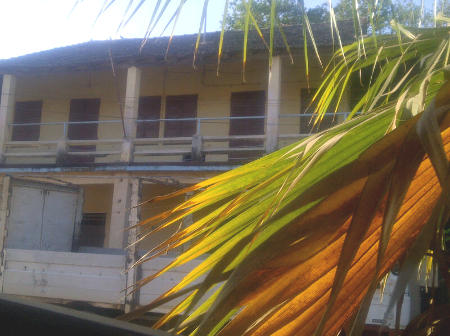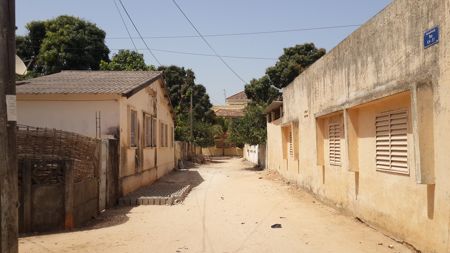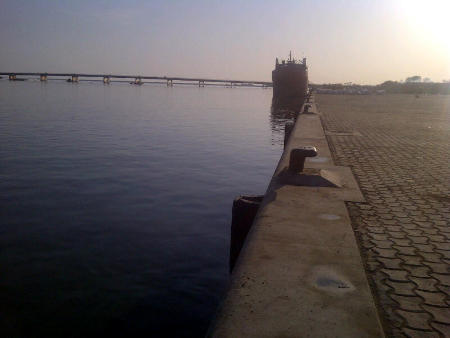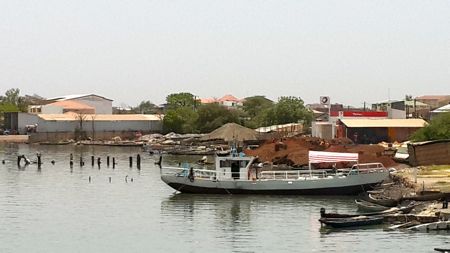Ziguinchor, Gateway to the Casamance

The riverfront is commanded by an imposing set of concrete wharfs where the fishing boats offload their catch and where the Senegalese military maintains part of its flotilla for patrolling the Atlantic. Flocks of graceful cranes skim a few meters of the river water, white with black wing tips. In the afternoon light, they wade at the water's edge, picking in the grass. But the town itself, rows of two story stucco homes in colonial architecture and tiled roofs, shadowed by coconut palms and fronds of bougainvillea, does a brisk regional trade in the usual goods.
It's hard to imagine a river port town that doesn't have a certain buzz to
it. Senegal's southern "capital," Ziguinchor, is no different. Call it
the stronghold of the Casamance, the economic and political center of a region
geographically separated from the rest of Senegal by the nation of the Gambia.
But it's also well-situated at the mouth of the formidable Casamance river, and
no matter what the political geography, its riverine geography makes it an
important place.

The riverfront is commanded by an imposing set of concrete wharfs where the
fishing boats offload their catch and where the Senegalese military maintains
part of its flotilla for patrolling the Atlantic. Flocks of graceful cranes skim
a few meters of the river water, white with black wing tips. In the afternoon
light, they wade at the water's edge, picking in the grass. But the town itself,
rows of two story stucco homes in colonial architecture and tiled roofs,
shadowed by coconut palms and fronds of bougainvillea, does a brisk regional
trade in the usual: packs of used clothing, Chinese radios, Pakistani butcher
knives, plastic kitchenware (Chinese, probably, but increasingly from Ghana and
Nigeria), and Taiwanese rubber sandals. There's a better selection of cellphones
for sale than back home in Washington DC. Women with basins on their heads and
children on their backs go about the day's chores, and trucks passing through on
their way to Guinea (Conakry), Guinea Bissau, and Dakar (Senegal) rumble through
clouds of acrid exhaust.

I have never felt ill-at-ease in Zig, and even appreciate its parrochial
atmosphere. But it's a place with a long history destined to grow a bit longer.
The Casamance has fought
a low-level insurgency for over 30 years, and it picked up again just as I
started traveling here. Never mind the growing hit-and-run banditry along the
highway, the Casamance rebels (technically, the Mouvement des Forces
Democratiques de la Casamance, MFDC) have effected increasingly daring runs
against the military garrisons of the Senegalese army. They've been responsible
for several
deaths and a few kidnappings of military personnel, and the military has not
hesitated to respond. There's another ghost in town, that of the Joola,
a passenger ferry from Dakar that sank during the night in September 2002,
killing almost all of the some 2000 passengers on board (officially 1863, but
the Senegalese believe it was more; in any case the boat was only rated for
500). Even I remember the accident, and it was long before I had any connection
to Senegal. The Senegalese say there isn't a family in the nation that didn't
lose someone on that boat, and as far as I can tell, it's true. Down by the
port, there's a monument to the victims.
 Meanwhile, the slow waters of the river pour out into the Atlantic, the fish
stack on ice in the market, and the markets bustle. There's so much potential
here, from the gorgeous Atlantic Coast of Cap Skirring, to the southern forests
and the limitless exploration up and down the river. It's a shame to see it go
mostly unexploited.
Meanwhile, the slow waters of the river pour out into the Atlantic, the fish
stack on ice in the market, and the markets bustle. There's so much potential
here, from the gorgeous Atlantic Coast of Cap Skirring, to the southern forests
and the limitless exploration up and down the river. It's a shame to see it go
mostly unexploited.
It's somewhat easy to feel like Zig is the capital of another country. Despite the trappings of northern Senegalese culture (the Wolof language, Islam), there are other cultures and languages here: Mankay, Jola, and a greater prevalence of Christianity. It's less arid than Senegal's Sahelien north: you notice the verdant, tropical ecosystem as the plane descends over the fields, and then there's that river, silent and powerful, and everything it represents. No wonder there's a buzz.
Trackbacks
The author does not allow comments to this entry

Comments
Display comments as Linear | Threaded